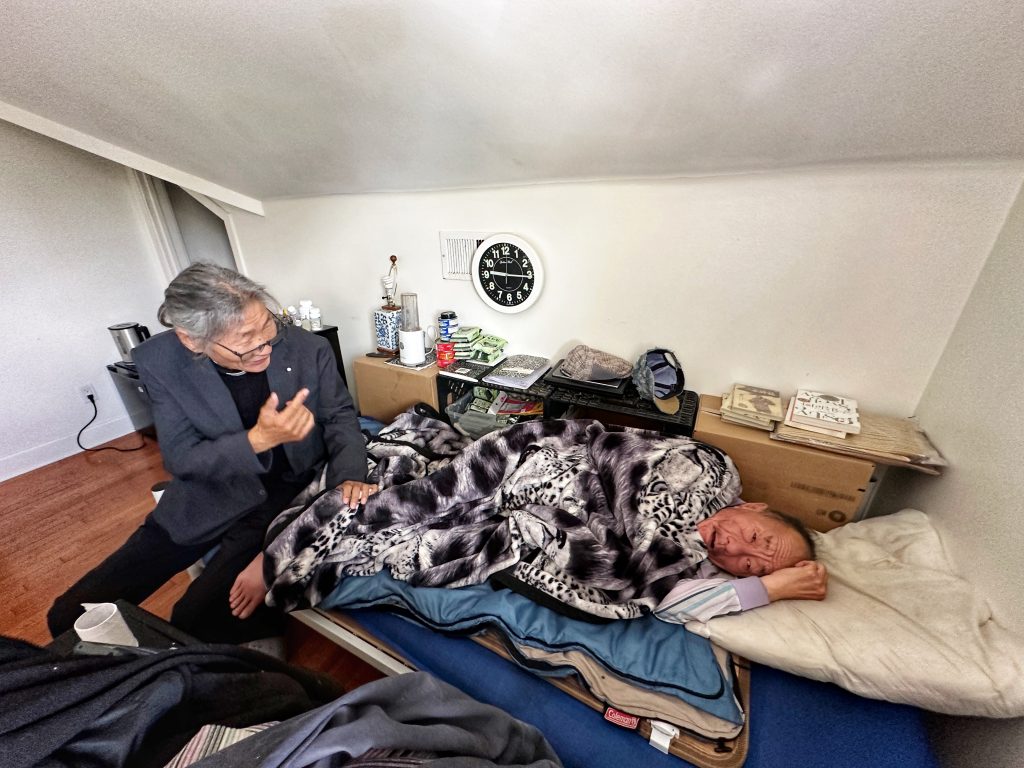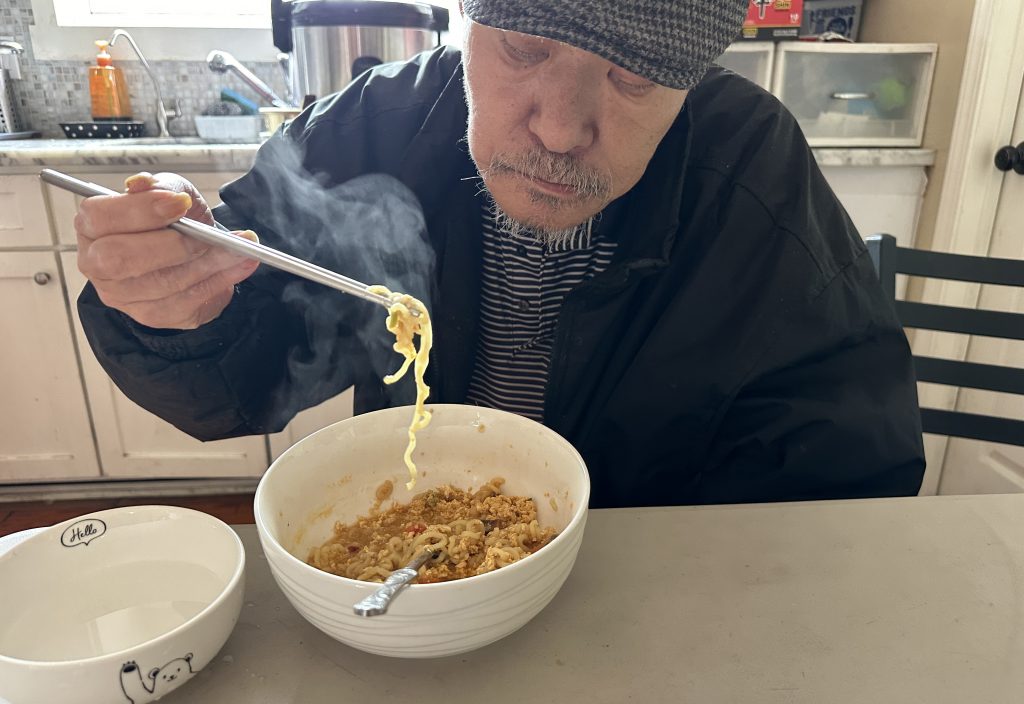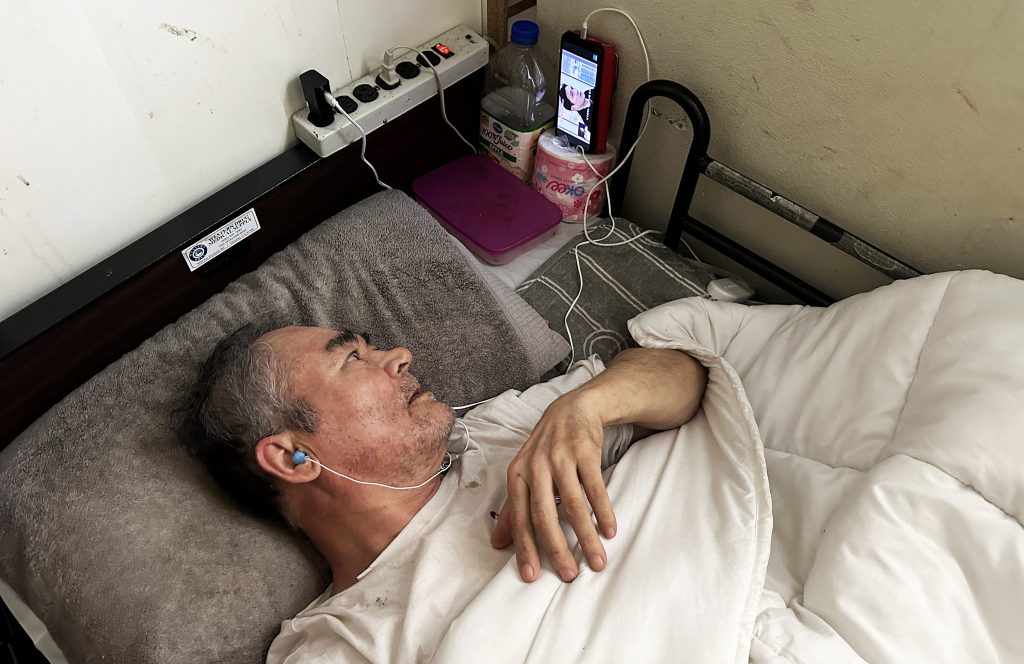[The Korea Daily-USC: Healing California Project]
“I, Young Seok, Ji Yoon, Seung Moon, Young Yang, will immediately leave if I ever drink at the shelter.” -September 10, 2019.
“Anyone who wishes to stay in the shelter must make the bed as the first thing in the morning when they wake up. That’s the only rule we have.”
A single-family home neighborhood near Washington Boulevard and South Gramercy Place, south of Los Angeles Koreatown, is as quiet and peaceful as the century-old neighborhood itself. In the front yard of a home on the corner, dozens of potted plants create a lively garden.

“This is the plant that Taehong Ahn, who passed away last week, and I took care of. We have to make the garden look nice so we don’t get judged by our neighbors. Say it’s rumored that there are a bunch of homeless people living in this expensive neighborhood. We keep getting fines and bills. We could get kicked out again.”
Father Yohan Kim, 68, a priest at St. James Episcopal Church, describes the neat gardening in the front yard of the house as a kind of “camouflage”. The single-family house is home to 20 Korean-American homeless people, providing them with food and shelter. It’s a sanctuary and a community that Father Kim formed with 20 elderly Korean-American homeless.
In the mid-2010s, Kim rented a house and began living with 16 Korean-American homeless people. Since then, Kim has provided food and shelter to more than 150 people. About 40 of them have been able to find jobs and rebuild their lives. His church members and devotees have been supportive of his efforts, but he hasn’t ever received any funding from the government including the city of Los Angeles.

Donations from Korean Americans, yet $0 from the government
Over the years, Kim and the homeless people have been evicted from their storefront and condominium at least three times after neighbor reports.
“This single-family house was donated to the church for homeless people by a Korean-American donor in 2019. Initially, we housed up to 30 people, but now we have reduced the number to 20 because we are afraid that the neighbors will report us. Even today I received a call that there is someone who wants to come to the shelter.”
Kim gives priority for free shelter room and board to Korean-American seniors who are 65 or older and homeless for more than a week. He is also helping about 10 Korean-American homeless people living in tents near Olympic Boulevard and St. Andrews Place in Koreatown. The late Taehong Ahn, who was found dead in the tent camp on the night of April 18, was one of the people who usually helped Kim deliver food and supplies from the shelter to other homeless people in the same situation.
On April 25, the shelter’s Korean-American homeless residents avoided appearing in the front yard of the house, perhaps conscious of their neighbors. Instead, they spent their time in the backyard garage, which had been converted into a utility room, watching TV, reading magazines, and playing Go.
At 6 p.m., in the shelter’s kitchen, a group of middle-aged Korean-American men prepared dinner. One senior man in his 70s boiled instant ramen noodles. The kitchen is directly connected to the backyard gate. On the wall above the refrigerator, several handwritten and signed memorandums said, “I will immediately leave the shelter if I drink alcohol.”

Home to 20 seniors 65 and older
This 4,000-square-foot shelter was originally a family home. It had five bedrooms and five bathrooms, including an attic. Kim made three additional rooms by partitioning off the living room to accommodate more Korean American homeless people. In a room, two to three people live as roommates, each with a single bed. The common areas, such as the restroom, laundry room, and kitchen, are kept spotlessly clean.
Most of them didn’t want their names and recognizable faces to be known. “We’ve been living together in the shelter for seven years,” said Chulsoo Kim (alias), 67, who was in the attic on the third floor of the sheltered house. “I was working as a construction worker, but I lost my job. Since then, I have no work and no strength. I came here through someone I knew.” Looking visibly ill, Kim said, “I can’t get back on my feet. My credit was ruined and I didn’t have many options.”
Robert Song (alias), 67, poured hot water into a rice bowl and made bean paste stew for dinner. “There’s rice in the rice cooker and kimchi in the fridge. Everyone is responsible for their own meals,” he said.
Song came to Los Angeles from Guatemala three years ago. His plans to work fell through, and he lived in a tent on a street near 6th and Catalina Streets in the Koreatown neighborhood. Subsequently, he was fortunate enough to stay at the shelter since January 2023.
“My specialty is in the sewing industry, but when I came to LA, I found that the sewing industry, including the Korean American java market, was dead. I couldn’t find a job because I don’t speak English, I don’t have any status or a driver’s license. Sleeping on the streets is not safe, so I’m very grateful for this shelter.”
Song has a wife and a son aged 22 in Guatemala. He is saving money as a plumbing assistant currently. “I’ve saved $2,600 so far,” he says, “and I’m going to make it to $10,000 so I can go see my family in Guatemala.”
Related Article
Father Yohan Kim wishes for shelters where the homeless become a family
BY HYOUNGJAE KIM, HOONSIK WOO [kim.ian@koreadaily.com]




